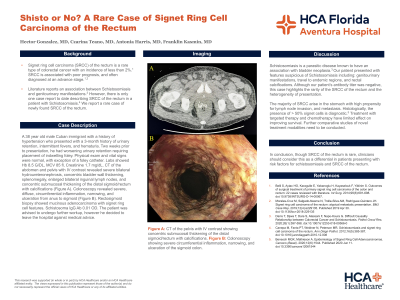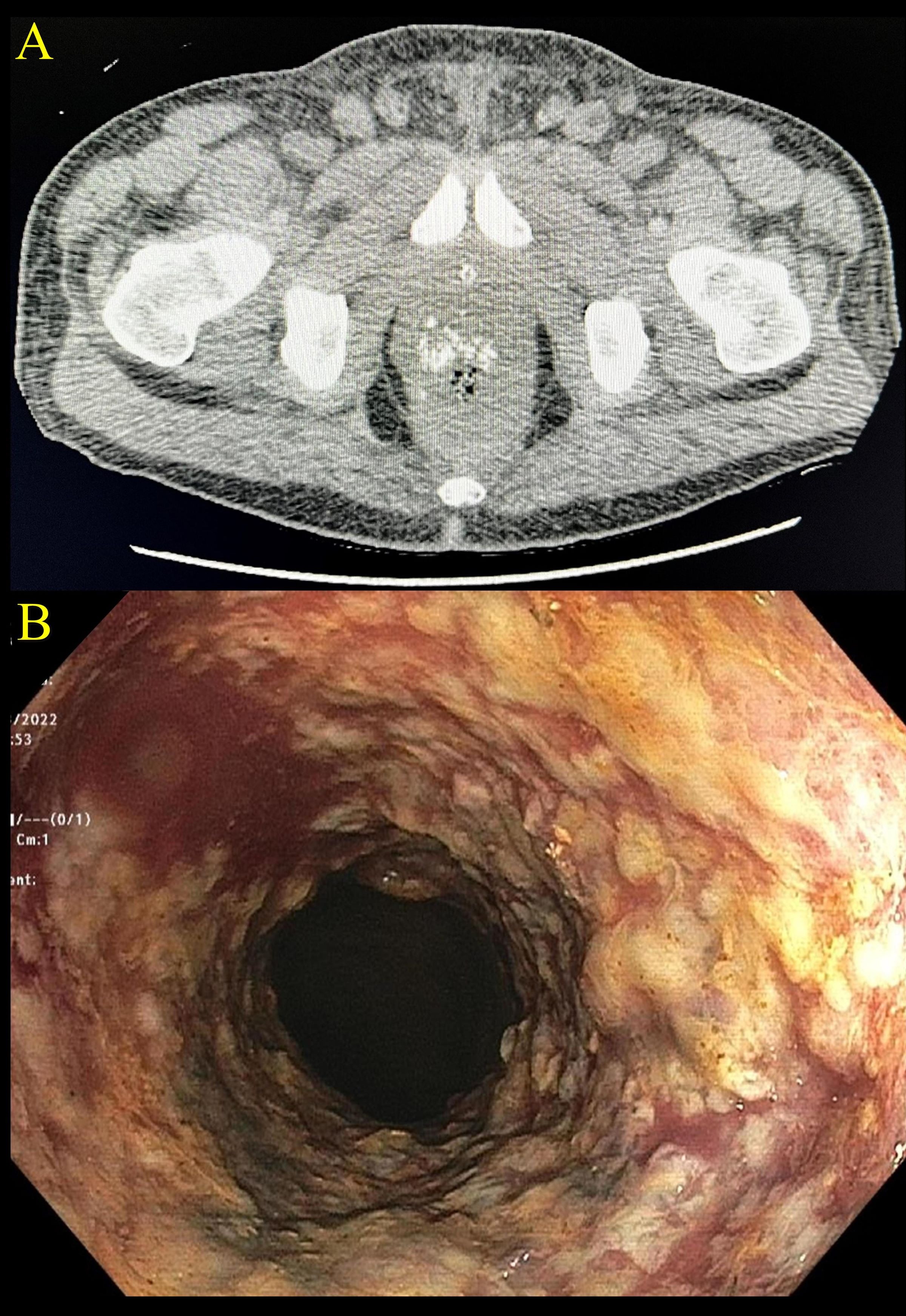Back


Poster Session C - Monday Afternoon
Category: Colon
C0130 - Shisto or No?: A Rare Case of Signet Ring Cell Carcinoma of the Rectum Mimicking Schistosomiasis
Monday, October 24, 2022
3:00 PM – 5:00 PM ET
Location: Crown Ballroom

Has Audio

Hector H. Gonzalez, MD
HCA Florida Aventura Hospital
Aventura, FL
Presenting Author(s)
Hector H. Gonzalez, MD, Czarina Teano, MD, MPH, Antonia Harris, MD, Franklin Kasmin, MD
HCA Florida Aventura Hospital, Aventura, FL
Introduction: Signet ring cell carcinoma (SRCC) of the rectum is a rare type of colorectal cancer with an incidence of less than 2%. SRCC is associated with poor prognosis, and often diagnosed at an advanced stage. While rare in the general population, SRCC occurs in up to 25% of schistosomiasis associated colorectal cancer. We report a case of SRCC in a patient with clinical features that mimicked colorectal and genitourinary schistosomiasis.
Case Description/Methods: A 38 year old male immigrant from rural Cuba presented with a 3 month history of urinary retention, intermittent fevers, and hematuria requiring placement of indwelling foley. Physical exam and vital signs were otherwise normal. Hb was 8.5 G/DL, MCV 85 fl, Creatinine 1.7 mg/dL. CT of the abdomen and pelvis with IV contrast revealed severe bilateral hydroureteronephrosis, concentric bladder wall thickening, splenomegaly, enlarged bilateral inguinal lymph nodes, and concentric submucosal thickening of the distal sigmoid/rectum with extensive calcifications. Colonoscopy revealed severe, diffuse, circumferential inflammation, narrowing, and ulceration from anus to sigmoid. While colitis was suspected, rectosigmoid biopsy showed mucinous adenocarcinoma with signet ring cell features. While we suspected schistosomiasis, Schistosoma IgG Ab was normal. The patient was advised to undergo further workup and chemotherapy, but he declined further treatment.
Discussion: Schistosomiasis is a parasitic disease known to have an association with bladder neoplasia and gastrointestinal manifestations in the form of colitis and rectal calcifications. We suspect that due to his extensive rectosigmoid cancer our patient presented with features mimicking schistosomiasis, namely extrinsic genitourinary compression causing hydroureteronephrosis with hematuria, and cancer appearing like colitis. This case is instructive in that we are reminded of the interesting presentation of schistosomiasis as well as the occasional presence of signet cell cancer in the lower gastrointestinal tract. While the majority of SRCC arise in the stomach, occasionally this entity can present as an isolated primary SRCC of the rectum. Treatment with targeted therapy and chemotherapy have limited effect on improving survival. In conclusion, though SRCC of the rectum is rare, clinicians should consider this in the differential in patients presenting with risk factors for both schistosomiasis and SRCC of the rectum.

Disclosures:
Hector H. Gonzalez, MD, Czarina Teano, MD, MPH, Antonia Harris, MD, Franklin Kasmin, MD. C0130 - Shisto or No?: A Rare Case of Signet Ring Cell Carcinoma of the Rectum Mimicking Schistosomiasis, ACG 2022 Annual Scientific Meeting Abstracts. Charlotte, NC: American College of Gastroenterology.
HCA Florida Aventura Hospital, Aventura, FL
Introduction: Signet ring cell carcinoma (SRCC) of the rectum is a rare type of colorectal cancer with an incidence of less than 2%. SRCC is associated with poor prognosis, and often diagnosed at an advanced stage. While rare in the general population, SRCC occurs in up to 25% of schistosomiasis associated colorectal cancer. We report a case of SRCC in a patient with clinical features that mimicked colorectal and genitourinary schistosomiasis.
Case Description/Methods: A 38 year old male immigrant from rural Cuba presented with a 3 month history of urinary retention, intermittent fevers, and hematuria requiring placement of indwelling foley. Physical exam and vital signs were otherwise normal. Hb was 8.5 G/DL, MCV 85 fl, Creatinine 1.7 mg/dL. CT of the abdomen and pelvis with IV contrast revealed severe bilateral hydroureteronephrosis, concentric bladder wall thickening, splenomegaly, enlarged bilateral inguinal lymph nodes, and concentric submucosal thickening of the distal sigmoid/rectum with extensive calcifications. Colonoscopy revealed severe, diffuse, circumferential inflammation, narrowing, and ulceration from anus to sigmoid. While colitis was suspected, rectosigmoid biopsy showed mucinous adenocarcinoma with signet ring cell features. While we suspected schistosomiasis, Schistosoma IgG Ab was normal. The patient was advised to undergo further workup and chemotherapy, but he declined further treatment.
Discussion: Schistosomiasis is a parasitic disease known to have an association with bladder neoplasia and gastrointestinal manifestations in the form of colitis and rectal calcifications. We suspect that due to his extensive rectosigmoid cancer our patient presented with features mimicking schistosomiasis, namely extrinsic genitourinary compression causing hydroureteronephrosis with hematuria, and cancer appearing like colitis. This case is instructive in that we are reminded of the interesting presentation of schistosomiasis as well as the occasional presence of signet cell cancer in the lower gastrointestinal tract. While the majority of SRCC arise in the stomach, occasionally this entity can present as an isolated primary SRCC of the rectum. Treatment with targeted therapy and chemotherapy have limited effect on improving survival. In conclusion, though SRCC of the rectum is rare, clinicians should consider this in the differential in patients presenting with risk factors for both schistosomiasis and SRCC of the rectum.

Figure: A. CT of the pelvis with IV contrast showing concentric submucosal thickening of the distal sigmoid/rectum with calcifications.
B. Colonoscopy showing severe circumferential inflammation, narrowing, and ulceration of the sigmoid colon.
B. Colonoscopy showing severe circumferential inflammation, narrowing, and ulceration of the sigmoid colon.
Disclosures:
Hector Gonzalez indicated no relevant financial relationships.
Czarina Teano indicated no relevant financial relationships.
Antonia Harris indicated no relevant financial relationships.
Franklin Kasmin indicated no relevant financial relationships.
Hector H. Gonzalez, MD, Czarina Teano, MD, MPH, Antonia Harris, MD, Franklin Kasmin, MD. C0130 - Shisto or No?: A Rare Case of Signet Ring Cell Carcinoma of the Rectum Mimicking Schistosomiasis, ACG 2022 Annual Scientific Meeting Abstracts. Charlotte, NC: American College of Gastroenterology.
